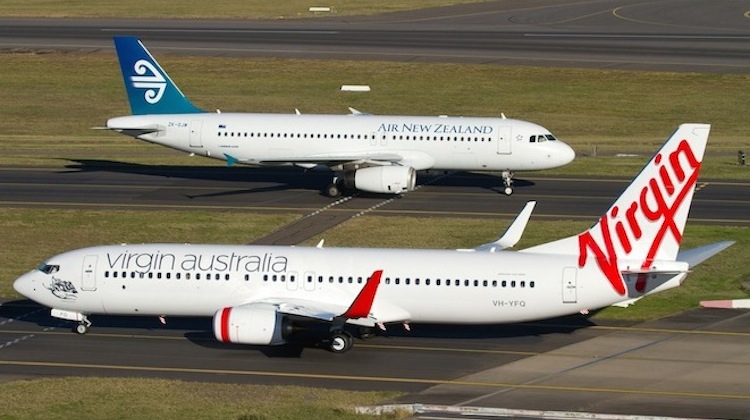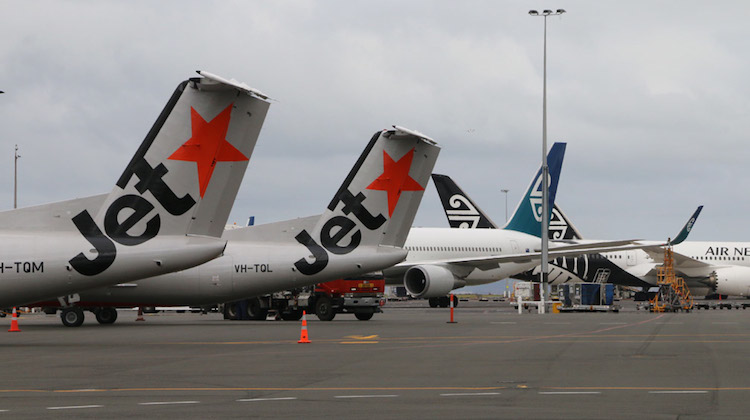
Virgin Australia has raised the proposed codeshare agreement between Air New Zealand and Qantas with the nation’s competition watchdog.
In April, Air New Zealand decided to walk away from its alliance with Virgin Australia in favour of going it alone on in the trans-Tasman market.
Two months later, the New Zealand carrier signed a codeshare agreement with Qantas to gain access to Australian domestic destinations it does not fly to. Similarly, Qantas will codeshare on Air New Zealand-operated domestic flights.
Both Air New Zealand and Qantas have stressed that because the arrangement did not involve any codesharing or coordination on international flights between Australia and New Zealand, it was not subject to regulatory approval on either side of the Tasman.
However, Virgin Australia has previously described the proposed codeshare as bad for consumers, while airport groups have also criticised the proposed arrangements.
Borghetti said Virgin Australia has provided its response to the deal to the Australian Competition and Consumer Commission (ACCC).
“On a standalone basis you read it and you look at it and you say it doesn’t really make sense so flick the page,” Borghetti told delegates at the CAPA – Centre for Aviation Aviation and Corporate Travel summit. “What’s part two here, because this can’t be the whole story?”
“I believe there could be a part two and I think that would be more worrisome for competition on the Tasman. We’ve made some comments about that formally through regulators and we will continue to make them.
“I think I probably can’t say more than that.”
#VirginAustralia CEO John Borghetti tells the #CAPASummit in Sydney he believes Australia has the best and most competitive domestic market in the world pic.twitter.com/08kda3WfI2
— World of Aviation (@the_wofa) August 2, 2018
An analysis of figures from Australia’s Bureau of Infrastructure, Transport and Regional Economics (BITRE) shows Air New Zealand held about 33 per cent market share for travel between Australia and New Zealand in calendar 2017, followed by Qantas on 18 per cent.
Virgin Australia carried the third most passengers in calendar 2017 at about 15 per cent, while Jetstar was fourth with 11 per cent. A host of fifth-freedom carriers such as China Airlines, LATAM and Singapore Airlines made up the rest.
Under the deal, Air New Zealand would add its NZ airline code on 85 Qantas-operated domestic services in Australia, while Qantas would place its QF code on 30 Air New Zealand-operated domestic services in New Zealand for travel from October 28 2018. There was also reciprocal lounge access for eligible frequent flyers.
Air New Zealand Christopher Luxon said recently the deal had been “misrepresented in the media quite a bit”.
“Because there is no coordination of pricing, no coordination of capacity, no coordination of scheduling, there is no regulatory involvement in it at all,” Luxon said at Air New Zealand’s investor day in mid-June.
Meanwhile, Qantas chief executive Alan Joyce said: “A codeshare deal on our domestic markets makes sense for our customers because it leverages the strengths we each have in our home markets.”
Jetstar group chief executive Gareth Evans promised in early June there would be no change to low-cost carrier’s (LCC) operations in New Zealand following the codeshare deal.
Further, the Qantas group remained fully committed to Jetstar New Zealand.
Jetstar operates a mix of Airbus A320s and Q300 turboprops serving nine destinations in domestic New Zealand. The LCC is the only non-Air New Zealand option on the key trunk routes linking the major cities, as well as on a number of regional points from its Auckland hub.
Qantas already codeshares on Jetstar New Zealand’s domestic flights and that arrangement would remain unchanged post October 28 2018.

Borghetti said the part of the codeshare he didn’t understand was Qantas putting its QF code on Air New Zealand domestic services when there was already a Jetstar domestic operation in New Zealand.
“It just doesn’t kind of ring true to me,” Borghetti said.
“But I’m sure they’ve got their reasons and good luck to them. We’ve expressed our views, as I said, to the ACCC and others.”
Australian Airports Association (AAA) chief executive Caroline Wilkie has also called for regulators to examine the deal.
“It is essential the details of this agreement be publicly examined by the competition authorities to ensure it has no anti-competitive effects,” Wilkie said in early June.
Ending of the alliance has spurred product and network changes
Borghetti said he could not remember at time in his 45 years in aviation where “two carriers whoever they may be, whether it is us or somebody else, haven’t wanted to do an alliance on the Tasman”.
“I’ve never experienced a situation where someone wants to get out of it. But there is a first time for everything,” Borghetti said.
Since April, both Virgin Australia and Air New Zealand have announced plans to increase capacity between Australia and New Zealand once the alliance is formally concluded to build their own presence in certain markets and balance their networks.
Virgin Australia is adding some new flights to Auckland, Queenstown and Wellington, as well as a new seasonal Newcastle-Auckland offering and adding its VA code to Singapore Airlines’ Melbourne-Wellington flights.
The latest announcement came on Tuesday, when Virgin Australia announced plans to offer a 23kg checked baggage allowance and a “substantial meal and drink” for economy passengers on all trans-Tasman flights from October 28 alongside an improved points and status credits earning rate.
The airline has also promised to have inflight internet Wi-Fi available on every trans-Tasman flight by the end of October, with 15 minutes complimentary access and a range of packages available for purchase.
Borghetti said he was very confident the product enhancements, among other initiatives, would ensure Virgin Australia retained its share of passengers on the Tasman once its alliance with Air New Zealand was wound up.
“One of our biggest issues in the alliance was the feedback from our own customers that flew domestically that said every time I get on your plane to go to New Zealand I get a different proposition than I get domestically. Why?” Borghetti said.
“It did create a little bit of a disjoint customer satisfaction in terms of expectations and fair enough too. But that will go away.”
Meanwhile, Air New Zealand plans to boost its schedule to Brisbane, Melbourne and Sydney, and add more widebody services on the Adelaide-Auckland route over the summer months.
Tigerair Australia still under consideration to fly on the Tasman
While Virgin Australia has previously flagged the option of having its LCC Tigerair Australia expand into the trans-Tasman market, Borghetti was noncommittal about when that potentially might be.
“We may, at some point, go on the Tasman,” Borghetti said.
“Not tomorrow, but may at some point.”
Borghetti said the priority for new Tigerair Australia chief executive Merren McArthur was on the domestic business and the transition of the fleet from A320s to 737-800s.
Tigerair Australia was shortly due to pick up its fourth 737-800, which would bring the fleet to 15 aircraft.
VIDEO: Virgin Australia general manager for customer experience and product Tash Tobias talks about the airline’s Wi-Fi offering. (Video by Seth Jaworski)










